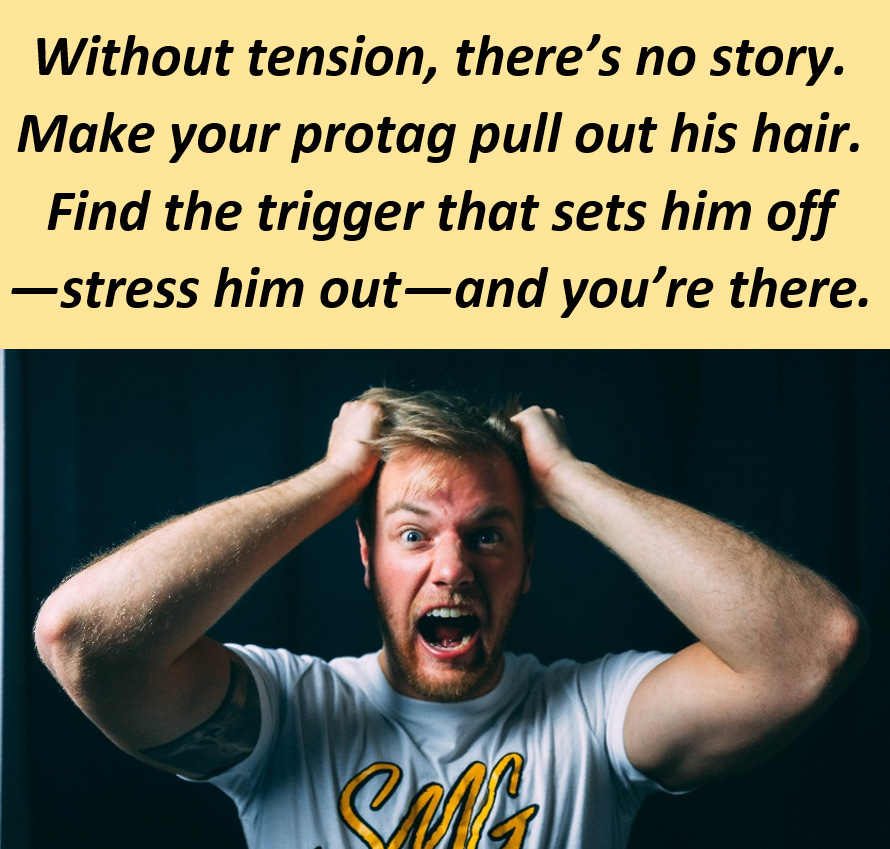Author and coach Jerry Jenkins tells how he and his wife have celebrated their 50th anniversary and “agree on almost everything. That’s a gift in real life,” he says. “In the pages of a novel? Boring.”
It’s true. Readers want great characters, but if nothing happens to them, who cares? The magic in any story is when an obstacle squashes goals and we get to see what those characters are made of.
Last issue we discussed Pantsers vs. Plotters. I have a friend who’s a pantser (a non-outliner who writes by the seat of their pants). She once shared a recurring issue she has pertaining to conflict. She gets so immersed in writing characters—coming up with them, writing dialogue for them, fleshing them out, having them interact—that she admitted she often reaches a stage where she suddenly realizes she hasn’t come up with a single conflict for those wonderful characters to face. And so begins the rewriting, ’cause without conflict, she knows she has no narrative.
“The more conflict, the more interesting your story.” –Jerry Jenkins
Another self-described pantser, Allison Winn Scotch, has the right mindset. “…I just keep reminding myself to create conflict, conflict, conflict,” she said on WriterUnboxed.com. “Because through conflict comes action, and that action will propel both you and the reader through the plot and onto its satisfying resolution.”
The Types of Conflict
What are the categories when it comes to conflict in literature? There is not a superfluity (or an excessive amount) of choices. You might recognize cartoonist Tom Gauld’s seven tongue-in-cheek ideas of what writers experience:
For actual character conflict, you can boil it down to about five types.
Well-known examples of conflict-types in literature:
Character vs.
· Themselves—Hamlet, Death of a Salesman
· Other people—Les Misérables, All Quiet on the Western Front
· Nature—Moby Dick, The Old Man and the Sea
· The Unnatural—Dracula, The Exorcist
· Society—The Catcher in the Rye, Lord of the Flies
Can you have more than one conflict? Yes, as long as it’s compatible with the overall story. A good additional one is pitting your protagonist against themselves.
Because who doesn’t like to read of an internal struggle in addition to the main conflict of the plot?
Consider The Godfather, by Mario Puzo. The primary conflict is surely man vs. man, but Puzo wove in a striking interior struggle with Michael Corleone, whose arc (we’ll cover more on character arc in a future issue) takes him on a twisting journey from morally upright war hero who rejects Mafia ties to becoming the new Don of the family. This interior conflict alone is arguably what makes the story (both in book and movie form) so powerful.
A personal example: my upcoming Touch series has a psychic detective who uses his skill to solve different serial killing cases (Man vs. Man). But there’s also a running interior conflict detailing his struggle with using his misuse of his psychic ability in his personal life (Man vs. Himself).
We’ll have more on interior/exterior struggle through the prism of character motivation in the future. But for now, here’s an important reminder when looking ahead to the end of your book. Your main character has to do the heavy lifting.
You should avoid magical solutions, or the convenient appearance of other characters who step in to take the burden off the shoulders of your main player. The conflict(s) in your book should be faced down by your lead, who can then solve it or be crushed by it. Because here’s a weird secret: the reader is really not as interested in the resolution of the conflict itself as in how the protagonist changes to try to make that resolution happen. Bringing in outside forces to tie conflict up in a neat bow cheats the reader out of that.
Last thing. I had a student who was considering dialing back the stressors she had written for her main character—which leads us to
Q: If I put my protag through too much, won’t it turn off readers?
A: I told her No. On the contrary. Amp it up. Readers want that roller coaster ride of empathizing with a challenged character—and they’ll love that character all the more if she/he stands up against the challenge.
Before we go, let’s rescue a word from obscurity. Remember this one? Hint: you might think it’s unnecessary, but you’d be wrong. Go back, find it in this issue, pronounce it, then save it by making it yours.
What is superfluity?
Remember, you’re not only saving a word—you’re adding it to your writing arsenal.
Action Plan
Come to craigstrickland.net to contact me, see my fiction—and learn about “The Spider Bite Murders,” first book of the Touch Series, date to be announced soon. Check the site for more info).
With only a touch, Michael Calrissi can read your thoughts. His psychic skills, however, are a double-edged sword: an effective tool for tracking down serial killers, but an obstacle for keeping friends or lovers.
In “The Spider Bite Murders,” he investigates a string of disappearances in a remote California forest. Soon, Calrissi psychically pries into the secrets of both his detective partner and a would-be girlfriend, alienating both. His skill also reveals that something—or someone—is living in the oaky canyons, using deadly spiders as a weapon. Can Calrissi channel his abilities and crack the ghoulish case, rebuild the bridges he’s torched, and save the lives of the two people closest to him?
Next up:
#14) Dream Up your Theme. See you in two weeks!
Craig



















Thanks for this!